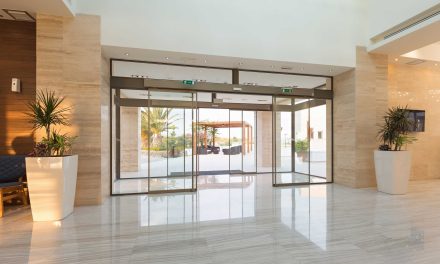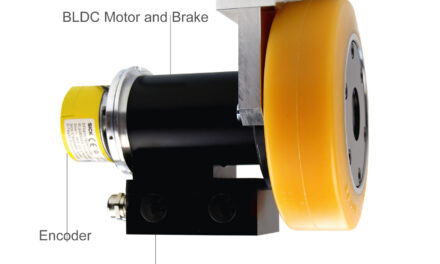 Through the use of variable speed drives and motors, and the appropriate software and hardware for control, highly accurate positioning of products and machinery is possible. Neil Ritchie from ABB comments
Through the use of variable speed drives and motors, and the appropriate software and hardware for control, highly accurate positioning of products and machinery is possible. Neil Ritchie from ABB comments
Motion control is the practice of controlling the position of a product or machine using variable-speed drives (VSDs), motors and ancillary equipment. Standard VSDs normally
control the motor by giving a speed command, a method which typically has no feedback, and speed references are pre-set using 0 to 10 Volts, 4-20 mA, or fieldbus.
Speed controlled drives change speed mainly in steps. The response here is not very fast, as the drive does not follow a continuously changing reference track and frequently has to ramp up its output from one level to another.
 If a standard drive is used for positioning, the motor normally runs at high speed and then decelerates to a lower speed and stops; or, it can follow an analogue signal. In both cases, no reference profile is followed, meaning that errors cannot be detected or corrected for, resulting in low accuracy.
If a standard drive is used for positioning, the motor normally runs at high speed and then decelerates to a lower speed and stops; or, it can follow an analogue signal. In both cases, no reference profile is followed, meaning that errors cannot be detected or corrected for, resulting in low accuracy.
With motion control, however, there is always feedback. The motor follows a continuously changing reference – a motion profile – which is compared to the feedback of the real position, generating a correction signal that is fed to the speed controller.
For motion control, a high performance system will be required, which will have one or more of the following characteristics: high dynamic performance; high accuracy reference following and repeatability; high accuracy motion functions; ability to run different motor types.
Functional parts of a machine
 Machines using motion control and/or high performance drives consist of the following, all of which affect the performance of the system:
Machines using motion control and/or high performance drives consist of the following, all of which affect the performance of the system:
- Motion control hardware: this controls the operation of the system. It can be centralised or decentralised
- Motion control software: determines the functions of the machine by receiving input data and handling this according to the instructions set out in the software code
- Drive or amplifier: receives commands from the motion control software
- Motor: provides mechanical energy with the required speed and torque to drive the load in the specified way
- Mechanical power transmission components: belts, gearboxes, clutch, ball screws, etc.
We can illustrate these principles with some example applications showing how products or tools are positioned. A basic setup is shown in Figure 1.
Here, the distance between boxes on the conveyor belt varies, and the purpose of the motion control software is to accelerate or decelerate the belt and space the boxes equally.
This conveyor has a feed belt, an adjusting belt and a receiving belt. The drive receives the line speed reference from the encoder. The sensor follows the rises and falls of the top line of the boxes and, when it detects a box, it follows its top edge until length of the box is run. The dropping edge is seen by the sensor and the distance to the next rising edge is the actual gap between boxes. This is compared to the required gap, with the software making the necessary correction by altering the speed of the adjusting belt.
Cyclic correction
The machine in Figure 2 corrects any angular error of the material. Two drives are used in a master/follower set-up – the master determines the main line speed, the follower receives a speed reference. Two sensors are connected to digital inputs. The follower calculates the error distance in number of pulses between two sensor signals and this is corrected by increasing or decreasing the speed of the follower. Depending on the application, different types of motors can be selected. Feedback will always be required.
Rotary knife
In Figure 3 a rotary knife is used to cut material into required length or cut off unwanted material. There are, however, a number of considerations for rotary knife operations. Firstly, if the cutting length varies it must be decided whether the tool should be at standstill or rotate continuously. Secondly, when the tool hits the material, it will in most cases need to have the same speed as the line. Thirdly, it is important to determine where to place the cut.
For more sophisticated applications the knife must form a motion profile during the cycle. When the knife is at standstill and a cut command is given, it has to accelerate to reach the position and then decelerate to cutting speed. After cutting, the tool should return
to the home position for the next cut. In some cases it may have to start another cut ‘on the fly’, meaning using two profiles added together. Cam profiles, which have master and follow positions set by the user, are normally used in such situations.
Whilst most motion controllers use CAM profiles for applications like rotary knives, ABB motion control products offer an additional method – FLY. This has been developed as a software function to simplify the programming of applications such as rotary and linear flying shear cutters.
Accurate control
Accurate motion control is a fundamental part of modern manufacturing applications and contributes significantly to achieving optimum production capacity, maintaining product quality, minimising waste and ensuring a safe working environment. With modern variable-speed drives matched with servo motors and capable of communication over standard protocols such as Ethernet, designers have the building blocks they need to construct workable motion control based machines that meet all these criteria.
ABB
T: 01925 741111



